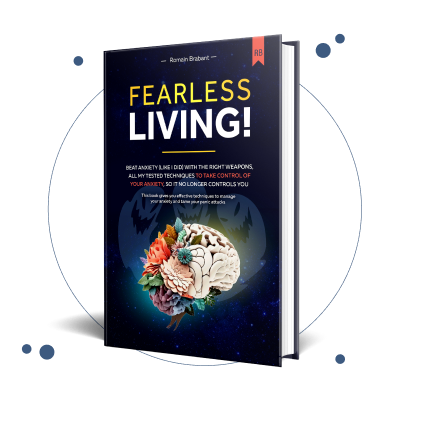
Anxiety can feel like an inescapable prison, trapping you in a cycle of worry, fear, and panic. It whispers catastrophic 'what ifs' until your world shrinks, defined by what you must avoid. But there is a clear and proven way to systematically dismantle this prison, one thought at a time. This isn't just about coping with anxiety; it's about fundamentally rewiring the thought patterns that fuel it, offering a genuine path toward healing and a panic-free life.
Cognitive reframing is a powerful, evidence-based technique from Cognitive Behavioral Therapy (CBT) that teaches you how to challenge and change the automatic negative thoughts that trigger anxiety. It’s about taking control of your internal narrative, not just enduring it. Hope is more than just a feeling; it is an active strategy for recovery.
This guide provides direct, actionable cognitive reframing examples to show you exactly how this process works. We will break down common anxious thought patterns, such as catastrophizing and all-or-nothing thinking, and provide clear, step-by-step scripts to transform them. Forget vague advice. Here, you will find concrete tools to intercept anxious thoughts, reframe them into realistic and empowering alternatives, and begin your journey to reclaim a life of freedom from chronic anxiety.
1. Catastrophizing to Realistic Perspective
Catastrophizing is a cognitive distortion where our minds immediately jump to the absolute worst-case scenario, no matter how improbable. It’s the mental habit of turning a minor setback, like a small mistake at work, into an imagined full-blown catastrophe, such as job loss and homelessness. This reframing technique directly confronts that pattern by grounding your thoughts in reality, offering a powerful path to reduce anxiety and regain a sense of control. The goal isn't to pretend problems don't exist, but to see them in their true, manageable size, which is a vital step toward healing.

This method, pioneered by figures like Aaron Beck, involves a deliberate shift from fear-based fiction to evidence-based fact. By systematically questioning your automatic negative thoughts, you can dismantle the anxiety they create and see that a more balanced, less frightening outcome is almost always more likely. It provides incredible hope by demonstrating that you can interrupt the cycle of panic before it spirals, paving the way for a calmer, more panic-free life. If you find these thought patterns are a frequent challenge, learning some practical tips to stop overthinking can provide additional strategies for finding calm.
Example in Action
- Automatic Thought (Before): "My boss didn't smile at me in the hallway. She must hate the report I submitted. I'm definitely getting fired at our one-on-one meeting this afternoon."
- Cognitive Reframing (After): "My boss seemed preoccupied, which could be for any number of reasons unrelated to me. My last performance review was positive, and one report doesn't usually lead to firing. I can approach the meeting calmly, knowing I have the strength to handle the conversation."
Strategic Breakdown and Application
To apply this cognitive reframing example effectively, use these actionable steps:
- Identify the Catastrophe: Clearly articulate the worst-case scenario you've imagined. Writing it down makes it tangible and easier to challenge.
- Examine the Evidence: Create two columns. In one, list evidence for your catastrophic thought. In the other, list evidence against it. Often, the "against" column will be much longer and more fact-based.
- Consider Alternatives: Brainstorm other, more likely outcomes. What is a more realistic scenario? What is the best-case scenario? The actual result will likely fall somewhere in the middle.
- Create a Balanced Thought: Formulate a new thought that acknowledges the reality of the situation without the exaggerated fear. This new perspective is your reframed thought, your first step towards calm.
This method is particularly useful when you feel a surge of anxiety about a future event. By breaking the habit of catastrophizing, you learn to trust your ability to handle challenges, which is a key step toward lasting freedom from anxiety. To understand more about this pattern, you can learn more about common cognitive distortions.
2. Negative to Positive Reframing
Negative to Positive Reframing is a foundational technique that involves consciously shifting your focus from the negative aspects of a situation to its potential benefits, silver linings, or opportunities for growth. It doesn't mean ignoring or denying difficulties; instead, it broadens your perspective to include more constructive and empowering interpretations. This cognitive reframing example is a powerful tool for building resilience, fostering an optimistic outlook, and reducing the emotional weight of setbacks on your journey to healing.

Pioneered by leaders in positive psychology like Martin Seligman, this method directly counters the mind's natural negativity bias. It empowers you to see that even in challenging circumstances, there is potential for learning and positive change. By actively searching for the good, you can transform feelings of hopelessness into a sense of agency, providing a clear path toward a more balanced and panic-free life. For those struggling with persistent negative thought loops, practicing this shift can be truly transformative. Keeping a journal can amplify this effect; you can explore the benefits of using a gratitude journal for anxiety to build this new mental habit.
Example in Action
- Automatic Thought (Before): "My relationship ended, which means I've failed. I'm going to be alone forever because something is wrong with me."
- Cognitive Reframing (After): "The end of this relationship is painful, but it taught me what I truly need in a partner. This is an opportunity to grow and build a future that is more aligned with my personal values and happiness."
Strategic Breakdown and Application
To apply this cognitive reframing example effectively, use these actionable steps:
- Acknowledge the Negative: Start by validating your initial feelings. It's okay to feel upset, frustrated, or disappointed. Don't try to suppress the negative emotion.
- Search for the 'And': Use the "Yes, and…" technique. Acknowledge the difficult part ("Yes, I lost my job and it's stressful…") and then add a constructive perspective ("…and this gives me the opportunity to find a role that I'm more passionate about").
- Identify the Opportunity or Lesson: Ask yourself clarifying questions. What can I learn from this? Is there a skill I can develop because of this setback? How can this experience make me stronger?
- Formulate the Positive Reframe: Create a new, balanced statement that incorporates this opportunity or lesson. This becomes your reframed thought, focusing on growth rather than defeat.
This method is especially useful for processing past events or current unchangeable situations, helping you find peace and purpose. By practicing this shift, you train your brain to see possibilities instead of just problems, which is a cornerstone of healing from anxiety and building a hopeful future.
3. Personalization to Externalization
Personalization is a common cognitive distortion where we incorrectly assume disproportionate responsibility for negative events. It’s the mental habit of internalizing external situations, believing that someone else’s mood or a negative outcome is directly and solely your fault. This reframing technique challenges that assumption by externalizing, which means realistically assessing all contributing factors. The goal is not to deflect all responsibility but to distribute it accurately, freeing yourself from undue self-blame and guilt.
This approach, central to Cognitive Behavioral Therapy (CBT) developed by Aaron Beck, helps you see the bigger picture. It involves a deliberate shift from a self-centered view of causality to a more objective and compassionate one. By recognizing that other people’s actions, external circumstances, and pure chance play significant roles, you can dismantle the heavy burden of self-criticism. This provides immense hope, showing that you don't have to carry the weight of the world on your shoulders and can achieve a more peaceful, balanced mindset on your path to recovery.

The pie chart above illustrates how this cognitive reframing example works by visually distributing responsibility. While personalization might assign nearly 100% of the blame internally, a more balanced view acknowledges that your personal control is just one piece of a larger puzzle.
Example in Action
- Automatic Thought (Before): "My child got a poor grade on their math test. I must be a terrible parent for not helping them enough."
- Cognitive Reframing (After): "My child's grade is the result of many factors. The test might have been difficult, they could be struggling with the new topic, and maybe they were just having an off day. My role is to be a supportive factor, not the sole cause of every outcome. I can offer help without blaming myself entirely."
Strategic Breakdown and Application
To apply this cognitive reframing example effectively, use these actionable steps:
- Identify the Self-Blame: Pinpoint the exact negative outcome you are taking personal responsibility for. Write it down clearly.
- Create a Causality Pie Chart: Draw a circle and divide it into segments representing all potential contributing factors. Assign a percentage to each one: your influence, other people's actions, environmental factors, timing, etc.
- Distinguish Influence from Control: Ask yourself, "What did I have direct control over versus what did I only influence?" This helps separate your actions from the final outcome, which is often beyond your complete control.
- Formulate a Balanced Perspective: Craft a new thought that acknowledges your role (if any) while also giving weight to the external factors you identified. This becomes your realistic, reframed thought.
This method is particularly powerful for parents, managers, and anyone in a caregiving role who tends to feel overly responsible for others. It breaks the cycle of guilt and provides a path to self-compassion, which is essential for healing. Deepening your understanding of these internal narratives can be a profound step toward healing, and exploring tools like shadow work prompts for anxiety can further illuminate these patterns.
4. All-or-Nothing to Spectrum Thinking
All-or-nothing thinking, also known as dichotomous thinking, is a cognitive distortion that forces you to see the world in black-and-white terms. It leaves no room for nuance, classifying outcomes, people, and experiences as either perfect or a complete failure, good or entirely bad. This reframing technique transitions you from this rigid mindset to "spectrum thinking," where you learn to recognize and appreciate the vast gray areas in life, promoting a more flexible, accurate, and compassionate self-view.

This approach, central to frameworks developed by pioneers like David Burns and Albert Ellis, is about dismantling the harsh standards of perfectionism. It provides profound hope by showing that a single mistake does not negate all your effort, and one flaw doesn't make you a failure. By learning to see progress and success on a continuum, you can escape the paralyzing cycle of anxiety that comes from striving for an impossible ideal. Understanding the principles of this method can be a powerful step toward a calmer mind and a life free from panic. For those interested in its therapeutic roots, you can learn more about how Cognitive Behavioral Therapy addresses anxiety and these thought patterns.
Example in Action
- Automatic Thought (Before): "I ate a cookie, so my diet for the day is completely ruined. I might as well just eat whatever I want now. I'm a complete failure at being healthy."
- Cognitive Reframing (After): "I made one less healthy choice, but my other meals today were nutritious and aligned with my goals. Overall, I'm at about 80% of my nutrition plan for the day, which is still great progress. One small detour doesn't ruin the entire journey."
Strategic Breakdown and Application
To effectively shift from all-or-nothing to spectrum thinking, use these actionable steps:
- Use a Percentage Scale: Instead of labeling an outcome as "good" or "bad," rate it on a scale of 0-100%. Ask yourself, "What percentage of this task did I complete successfully?" This immediately forces your brain to find the partial successes.
- Separate Strengths and Weaknesses: Make two lists for any given situation: one for what went well, and one for areas that need improvement. This proves that both strengths and weaknesses can exist simultaneously without one invalidating the other.
- Replace Absolute Language: Actively identify and replace words like "always," "never," "perfect," and "ruined." Swap them for more flexible terms like "sometimes," "often," or "in this instance."
- Practice on Low-Stakes Situations: Build this mental muscle by applying it to everyday, low-pressure events. Rate your workout, your lunch, or a conversation with a friend on a spectrum to make the process a natural habit.
This cognitive reframing example is especially powerful for managing perfectionism and self-criticism. By embracing the "gray," you learn that progress, not perfection, is the key to growth, offering a liberating path toward living a panic-free life.
5. Problem-Focused to Growth-Focused Reframing
This powerful cognitive reframing technique shifts your perspective from seeing problems and deficits to spotting opportunities for growth and learning. Instead of viewing a challenge as a threat or a sign of inadequacy, you reframe it as a chance to develop new skills and expand your capabilities. This method is rooted in the "growth mindset" theory, which posits that our abilities are expandable through dedication and hard work, not fixed traits we are born with.
This approach, popularized by researchers like Carol Dweck, transforms the entire experience of facing a setback. It moves the focus away from the immediate, often painful outcome and places it squarely on the learning process. By adopting this mindset, you can dismantle the fear of failure that often fuels anxiety, replacing it with a sense of curiosity and resilience. It offers profound hope by showing that every obstacle is not a dead end but a stepping stone on your path to becoming more capable and confident.
This shift provides a clear path forward, demonstrating that you are not defined by your current limitations but by your willingness to learn and adapt. For those feeling stuck in cycles of self-criticism, understanding the core principles of this method can be a crucial part of a larger healing process. Exploring the fundamental steps to anxiety recovery can provide a broader context for integrating such powerful mindset shifts.
Example in Action
- Automatic Thought (Before): "I got critical feedback on my project. I'm just not good enough at this, and I'll never succeed."
- Cognitive Reframing (After): "I received specific information on how to improve my skills. This feedback is a valuable roadmap showing me exactly where I can grow and become more effective. This is how I heal and get better."
Strategic Breakdown and Application
To apply this growth-focused reframing in your own life, use these actionable steps:
- Acknowledge the Setback: First, recognize the difficulty without judgment. It’s okay to feel disappointed or frustrated by a mistake or a challenge.
- Add the Word "Yet": Consciously add "yet" to the end of self-limiting statements. For example, "I can't do this" becomes "I can't do this yet." This small addition implies that future success is possible.
- Ask Growth-Oriented Questions: After a setback, ask yourself: "What did I learn from this experience?" and "What will I do differently next time?" This moves your brain from a state of threat to one of problem-solving.
- Reframe Criticism as Coaching: View any form of criticism or negative feedback not as a personal attack, but as a "development opportunity" or free coaching that provides clear directions for improvement.
This method is especially effective for combating perfectionism and the fear of failure. By celebrating effort and learning rather than just perfect outcomes, you build a resilient mindset that can handle life's inevitable challenges, paving the way for a calmer, more confident life.
6. Obligation to Choice Reframing
The language of obligation, filled with "I have to," "I must," and "I should," often creates feelings of powerlessness, resentment, and anxiety. This cognitive reframing example targets that internal pressure by consciously shifting your perspective from one of forced duty to one of personal agency. By changing your internal monologue to "I choose to" or "I get to," you reclaim your autonomy and connect your actions to your underlying values, which can dramatically reduce feelings of being trapped and overwhelmed. This shift is not about denying responsibilities but about recognizing the power you hold in meeting them.
This powerful concept, underscored by thinkers like Viktor Frankl and William Glasser, emphasizes that even in difficult circumstances, we retain the freedom to choose our attitude and actions. Acknowledging this choice transforms mundane or stressful tasks from burdens into purposeful steps toward a desired goal. It offers a profound sense of hope by reminding you that you are the one in control of your life's direction, providing a pathway to a more motivated and panic-free existence. For those who feel weighed down by their to-do lists, this reframe can be a liberating first step toward a calmer mindset.
Example in Action
- Automatic Thought (Before): "Ugh, I have to go to work today. I don't want to deal with all that stress. I have no choice."
- Cognitive Reframing (After): "I choose to go to work today because I value providing for my family and using my skills. It aligns with my goal of financial security and professional growth."
Strategic Breakdown and Application
To effectively apply this obligation-to-choice cognitive reframing example, use these actionable steps:
- Identify the "Have To": Notice whenever you use words like "have to," "must," or "should." Pay attention to the feeling of resistance or resentment that often accompanies these thoughts.
- Uncover the Underlying Value: Ask yourself, "Why am I really doing this?" Dig deeper until you find the core value or goal the task supports. For example, you "choose to" do chores because you "value" a clean and peaceful living space.
- Rephrase with "Choose To": Consciously replace the obligation-based language with choice-based language. Complete the sentence: "I choose to [the action] because I value [the underlying reason]."
- Acknowledge the Alternative: Briefly consider what would happen if you didn't do the task. Recognizing the negative consequences of not acting reinforces that your action is, in fact, a conscious choice to avoid those outcomes.
This technique is especially potent for combating burnout and procrastination. By linking daily actions to your deeper purpose, you transform your routine from a series of obligations into a meaningful expression of what truly matters to you, fostering a sense of control and healing your relationship with your responsibilities.
6 Examples of Cognitive Reframing Compared
| Technique | Implementation Complexity 🔄 | Resource Requirements ⚡ | Expected Outcomes 📊 | Ideal Use Cases 💡 | Key Advantages ⭐ |
|---|---|---|---|---|---|
| Catastrophizing to Realistic Perspective | Moderate: requires practice and guidance | Low to Moderate: mostly mental effort, occasional professional help | Reduced anxiety, improved emotional balance, better decision-making | Anxiety, fear-based reactions, panic prevention | Builds resilience, prevents analysis paralysis |
| Negative to Positive Reframing | Low: simple mindset shift but requires genuineness | Low: practice and journaling recommended | Increased resilience, improved mood, enhanced creativity | General emotional wellbeing, coping with setbacks | Boosts optimism without denying difficulties |
| Personalization to Externalization | Moderate: requires honest self-assessment | Low to Moderate: reflection and possible therapy | Reduced guilt/shame, improved self-esteem, better attribution accuracy | High self-blame, social anxiety | Balances accountability, reduces excessive self-blame |
| All-or-Nothing to Spectrum Thinking | Moderate: needs regular practice to shift rigid thinking | Low: cognitive exercises and reflection | Reduced perfectionism anxiety, increased motivation, realistic goal-setting | Perfectionism, black-and-white thinking patterns | Encourages nuance, improves persistence |
| Problem-Focused to Growth-Focused Reframing | Moderate: involves mindset shift and patience | Low to Moderate: journaling and effort tracking | Increased motivation, resilience, skill development | Learning challenges, fear of failure | Promotes continuous growth, reduces risk-aversion |
| Obligation to Choice Reframing | Moderate: needs awareness and value identification | Low to Moderate: reflection and language shifts | Increased motivation, reduced resentment, enhanced autonomy | Obligatory tasks, low motivation situations | Enhances sense of control, clarifies decision-making |
Building Your Toolkit for a Panic-Free Life
The journey through this article has illuminated a powerful truth: your thoughts are not commands, but suggestions. By exploring these practical cognitive reframing examples, from shifting catastrophizing to a realistic perspective to reframing obligation as choice, you've witnessed how a simple change in perspective can dismantle the very foundation of anxiety. The goal isn't to erase negative feelings or pretend challenges don't exist. Instead, it's about building mental flexibility and recognizing that you have the power to change your internal narrative and heal.
Each strategy we've analyzed is more than just a concept; it's a functional tool for your mental health toolkit. Mastering them is a process of compassionate, consistent practice. It begins with the simple awareness of a single automatic negative thought and the courage to gently question its validity. This is the cornerstone of healing from anxiety and reclaiming a life where you are in the driver's seat, not your fear.
Key Takeaways for Lasting Change
Remember these core principles as you begin to apply these techniques:
- Awareness is the First Step: You cannot reframe a thought you don't recognize. Practice mindfulness to become an observer of your thoughts without immediate judgment.
- Start Small and Build Momentum: Don't try to tackle your biggest fears on day one. Practice on minor daily annoyances or small worries to build confidence and skill.
- Compassion Over Criticism: Beating yourself up for having anxious thoughts only adds another layer of stress. Treat yourself with the same kindness and patience you would offer a friend.
- Consistency Trumps Intensity: A few minutes of intentional practice each day is far more effective than a long, infrequent session. Make it a daily habit, like brushing your teeth.
As you build this toolkit, you might find that structured therapeutic approaches provide an excellent framework for applying these skills. For instance, many people find that exploring effective CBT techniques for ADHD to improve focus can also offer valuable, transferable strategies for managing the racing thoughts associated with anxiety. The underlying principle is the same: creating structured, actionable methods to manage your mind.
Ultimately, the power of cognitive reframing lies in its ability to restore hope. It demonstrates, with tangible proof, that a life free from the constant grip of panic and anxiety is not just a distant dream but an achievable reality. Every time you successfully challenge a distorted thought, you weaken the hold anxiety has on you and strengthen your own resilience. This is how you heal and build a panic-free life, one thought at a time.
Ready to turn these examples into a systematic, daily practice? The Anxiety Checklist provides a 93-point interactive checklist and customizable worksheets to help you transform theory into real, lasting change. Take the next step on your healing journey and build your personalized system for a panic-free life at The Anxiety Checklist.

